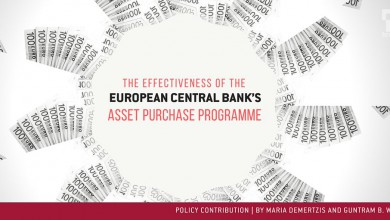Youth unemployment in the Mediterranean region has consequences for the whole of Europe. Tackling youth unemployment in the region must continue to be a high policy priority. This piece was first published on Bruegel and was prepared for a conference in Morocco.
Europe’s Mediterranean neighbourhood has become a focal point of attention due to the refugee crisis. With over a million people arriving in Europe in the course of 2015, the question of how to address the growing immigration pressures has become a central political issue.
Countries around the Mediterranean are also under scrutiny due to mounting security concerns in Syria, Libya and elsewhere. A range of economic literature links conflicts to demographic conditions and poor economic opportunities for young people. Countries undergoing “demographic transition”, resulting in very youthful populations, are especially vulnerable to conflict, in particular when economic opportunities are scarce (Homer-Dixon 1999; Kelley & Schmidt 2001; Urdal 2004; Kahl 2006).
Youth unemployment is an urgent issue in many countries across the Mediterranean region, where 25.4 million people are unemployed, of whom 7-8 million are aged 15-24. (World Bank 2014; United Nations World Population Prospects 2015). 490 million people live in the region, of which 192 million are part of the 8 EU member states.
The proportion of young people not in education, employment or training has increased since the financial crisis, and in many countries youth unemployment rates are higher than unemployment in the older working age population. The figures available may even underrepresent the true level of unemployment due to non-participation in the labour market.
The growth in youth unemployment is particularly worrying. It can have long-lasting effects on productivity and potential growth, often excluding young people from the labour market for an extended period of time, lowering their productivity and affecting their job prospects for life (Arulampalam 2001;Gregg and Tominey 2005).
The demographic structures of Mediterranean countries vary widely, as can be seen in Figure 1. Median ages in non-EU Mediterranean countries are generally lower than in EU Mediterranean countries. The two most populous non-EU Mediterranean countries, Turkey and Egypt, both have median ages well below any EU country.
Around the Mediterranean, the median age has increased substantially over the past two decades, but with significant differences across countries.
Over the past decade, growth per capita was higher for the non-EU Mediterranean countries. Figure 3 shows the average annual GDP per capita growth of the last ten years, based on purchasing power parities.
The low growth figures in the EU reflect the deep scars left by the euro-area crisis. Growth in non-EU countries was relatively robust in comparison, suggesting some income convergence, although from a low per-capita level.
Unemployment rates in the Mediterranean rose more sharply for EU member states than for non-EU Mediterranean countries over the past 10 years, again reflecting the economic crisis. Unemployment rates at least doubled between 2005 and 2014 for Cyprus, Greece and Spain, with the highest increase in Cyprus where the unemployment rate nearly tripled from 2005 to 2014. Unemployment rates also increased for four non-EU Mediterranean countries (Albania, Bosnia and Herzegovina, Egypt and Syria).
Youth unemployment rates, defined as the share of the labour force aged 15-24 without work but available for and seeking employment, increased much more than overall unemployment rates in most Mediterranean countries from 2005-2014.
Youth unemployment rates in Croatia, Cyprus, Greece, Italy, Slovenia and Spain rose more sharply than the EU average. Youth unemployment rates in the non-EU Mediterranean countries have also increased over the past ten years, including in those with already high youth unemployment rates such as Bosnia and Herzegovina, Egypt, Libya, Montenegro, Syria and Tunisia.
Labour force participation rates have remained similar to levels ten years ago although participation dropped in some EU countries including Croatia, France and Slovenia as well as in the non-EU countries Albania, Morocco, Montenegro and Syria. Israel’s labour force participation rate changed most, with an increase of almost 8 percentage points compared to a decade ago.
In a number of the Mediterranean countries, female unemployment is much higher than male unemployment, but this is likely distorted by the significant differences in participation rates of men and women. In the non-EU Mediterranean countries, female unemployment rates in Algeria, Egypt, Lebanon, Libya and Syria are at least 1.5 times as high as male unemployment rates, and, with the exception of Egypt, the difference has increased in the past ten years.
For most EU Mediterranean countries, male and female unemployment rates were similar in 2014, with lower female unemployment rates compared to male unemployment rates in Croatia, Cyprus, France and Germany. Notably, gaps between female and male unemployment rates – which used to be substantial – lessened in Greece, Italy and Spain between 2005 and 2014.
The Mediterranean faces a crisis of unemployment and youth unemployment that matters not only for the countries individually but also has wider implications, including for the EU as a whole. Initiatives in the region have failed to prevent high levels of youth unemployment (European Commission;European Training Foundation 2015; Koenig 2016).
Meanwhile, demographic pressures and immigration flows suggest that unemployment rates could increase further in the years to come. Tackling youth unemployment in the region should continue to be a high policy priority, but the focus must be on programmes that have demonstrated results. In addition, the EU’s neighbourhood policy needs to be given greater priority and should include some countries, such as Libya and Syria, which are currently at the margins of the partnership.


